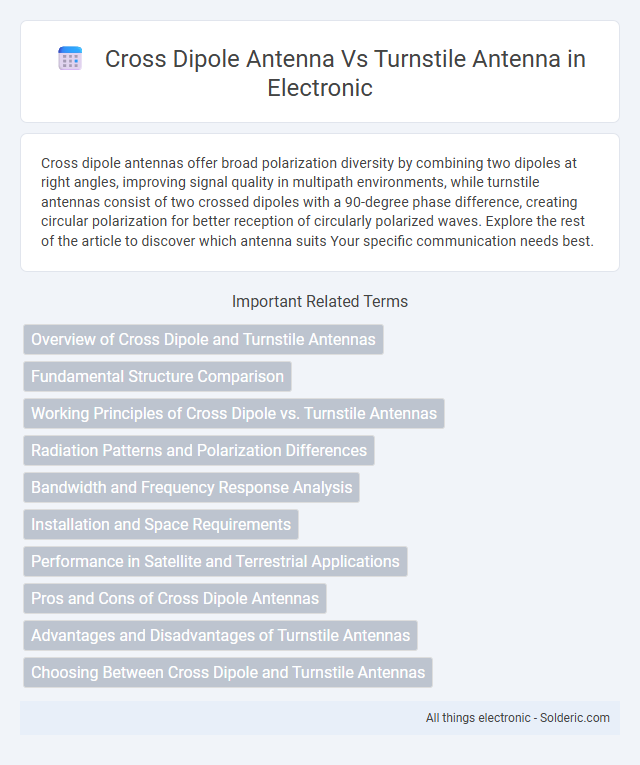Cross dipole antennas offer broad polarization diversity by combining two dipoles at right angles, improving signal quality in multipath environments, while turnstile antennas consist of two crossed dipoles with a 90-degree phase difference, creating circular polarization for better reception of circularly polarized waves. Explore the rest of the article to discover which antenna suits Your specific communication needs best.
Comparison Table
| Feature | Cross Dipole Antenna | Turnstile Antenna |
|---|---|---|
| Configuration | Two dipoles mounted at 90deg to each other | Two dipoles mounted at 90deg with a 90deg phase difference |
| Polarization | Linear or dual linear polarization | Circular polarization |
| Radiation Pattern | Bidirectional lobes, figure-8 pattern | Omnidirectional horizontal plane |
| Application | Simple communication, linearly polarized signals | Satellite communication, circular polarized signals |
| Impedance | Approx. 73 ohms per dipole | Approx. 75 ohms |
| Construction Complexity | Simple | Moderate (requires phase shifting) |
| Bandwidth | Narrow to moderate | Moderate, improved pattern stability |
Overview of Cross Dipole and Turnstile Antennas
Cross dipole antennas consist of two dipoles mounted at right angles, producing circular or elliptical polarization with broad coverage, making them suitable for satellite and VHF applications. Turnstile antennas combine two dipoles in phase quadrature, creating omnidirectional radiation with circular polarization, optimal for broadcast and communication systems requiring uniform signal distribution. Choosing between these antennas depends on your need for polarization type, coverage area, and application-specific requirements.
Fundamental Structure Comparison
The cross dipole antenna consists of two dipole antennas mounted perpendicularly and fed with 90-degree phase difference to produce circular polarization, while the turnstile antenna features two orthogonal dipoles driven in phase, resulting in an omnidirectional radiation pattern with linear polarization. Cross dipole antennas typically provide better circular polarization purity ideal for satellite communications, whereas turnstile antennas excel in broad, uniform horizontal coverage for applications like terrestrial broadcasting. The fundamental structural difference lies in the feeding and phase relationship that defines their respective radiation characteristics.
Working Principles of Cross Dipole vs. Turnstile Antennas
Cross dipole antennas operate by combining two perpendicular dipoles fed with a phase difference of 90 degrees, generating circular or elliptical polarization for omnidirectional coverage. Turnstile antennas consist of two dipoles arranged at right angles, also fed with quadrature phase, but are primarily designed to produce broad horizontal omnidirectional radiation with more uniform gain. Both leverage orthogonal elements and phase shifts to achieve circular polarization, but the turnstile antenna emphasizes stable horizontal patterns, while the cross dipole offers flexibility in polarization characteristics.
Radiation Patterns and Polarization Differences
A cross dipole antenna generates circular polarization by combining two perpendicular dipoles fed with a 90-degree phase difference, producing an omnidirectional radiation pattern ideal for satellite communication. In contrast, a turnstile antenna consists of two dipoles mounted at right angles and fed in phase or quadrature, creating an omnidirectional horizontal radiation pattern with either linear or circular polarization depending on the feed arrangement. The cross dipole's circular polarization improves signal reception regardless of antenna orientation, while the turnstile antenna offers versatile polarization modes suited for ground-based broadcast and VHF/UHF applications.
Bandwidth and Frequency Response Analysis
Cross dipole antennas exhibit a broader bandwidth due to their orthogonal element configuration, enabling effective operation over a wide frequency range with stable radiation patterns. Turnstile antennas, while also offering omnidirectional coverage, generally have a narrower bandwidth and more frequency-specific performance, making them ideal for applications requiring precise frequency tuning. Frequency response analysis shows cross dipoles maintain consistent impedance and polarization across various frequencies, whereas turnstile antennas tend to have optimized response at the designed center frequency with decreased efficiency outside that range.
Installation and Space Requirements
Cross dipole antennas require careful alignment and typically need more vertical space for proper installation, making them suitable for locations with height availability. Turnstile antennas have a compact, symmetrical design that enables easier mounting on limited rooftops or poles without extensive clearance. Your choice depends on the available installation space and the mounting structure's capacity to accommodate the antenna's dimensions.
Performance in Satellite and Terrestrial Applications
Cross dipole antennas offer improved circular polarization and wider bandwidth, making them ideal for satellite communications where signal consistency and orientation independence are crucial. Turnstile antennas provide omnidirectional coverage with horizontal polarization, suitable for terrestrial broadcasting and receiving applications requiring uniform signal distribution. Satellite systems benefit from the polarization purity of cross dipoles, while turnstile antennas excel in ground-level RF environments due to their simpler design and stable radiation patterns.
Pros and Cons of Cross Dipole Antennas
Cross dipole antennas provide circular polarization and wide bandwidth, making them ideal for satellite communications and radio astronomy. They offer relatively simple construction and good impedance matching but can suffer from lower gain compared to directional antennas. However, cross dipoles may experience polarization mismatch in certain applications, limiting signal strength and reliability.
Advantages and Disadvantages of Turnstile Antennas
Turnstile antennas offer omnidirectional radiation patterns with circular polarization, making them ideal for satellite and FM broadcasting applications where uniform signal distribution is crucial. They have moderate gain and simple construction but are typically larger and more complex than cross dipole antennas, which can be a disadvantage in space-constrained environments. Your choice depends on whether you prioritize circular polarization and consistent coverage over compact size and linear polarization.
Choosing Between Cross Dipole and Turnstile Antennas
Choosing between cross dipole and turnstile antennas depends on your desired radiation pattern and polarization needs. Cross dipole antennas provide circular polarization with high axial ratio, ideal for satellite communication and reducing multipath interference. Turnstile antennas offer omni-directional horizontal polarization, making them suitable for VHF/UHF broadcasting where uniform signal coverage is essential.
cross dipole antenna vs turnstile antenna Infographic

 solderic.com
solderic.com